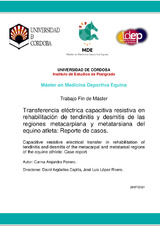Mostrar el registro sencillo del ítem
Transferencia eléctrica capacitiva resistiva en rehabilitación de tendinitis y desmitis de las regiones metacarpiana y metatarsiana del equino atleta: Reporte de casos
| dc.contributor.author | Panero, Carina Alejandra | |
| dc.date.accessioned | 2022-03-16T08:08:58Z | |
| dc.date.available | 2022-03-16T08:08:58Z | |
| dc.date.issued | 2022 | |
| dc.identifier.uri | http://hdl.handle.net/10396/22699 | |
| dc.description | Premio extraordinario de Trabajo Fin de Máster curso 2020/2021. Máster en Medicina Deportiva Equina | es_ES |
| dc.description.abstract | Debido al pico de fuerzas verticales que producen hiperextensión de las articulaciones metacarpo (metatarso)-falangianas, en el caballo atleta, hay una tasa alta de lesiones en los tendones flexores digitales superficiales y profundos, sus ligamentos accesorios y el “ligamento suspensor del menudillo”. Estas son una fuente de frustración debido a su inicio insidioso, amplios tiempos de curación y riesgo de reincidencia. Todo esto, sin un protocolo de tratamiento identificado que garantice un resultado universalmente exitoso. El objetivo de este trabajo fue reportar los resultados obtenidos con la terapia de transferencia eléctrica capacitiva resistiva (TECR), en la rehabilitación de estas patologías. Se reportaron 23 casos en caballos de diferentes disciplinas ecuestres tratados con TECR provenientes de 3 servicios de rehabilitación diferentes. La tasa de evolución favorable de las lesiones post tratamiento con TECR fue de un 91.3% (21 casos) para el total de los casos. La tasa general de recidiva sobre los casos de evolución favorable, fue de 19% (4 casos). Para las tendinitis (14 casos), la tasa de evolución favorable fue de un 92,8% (13 casos) y la tasa de recidiva fue de 30,8 % (4 casos). Para las desmitis (9 casos), la tasa de evolución favorable fue de un 88,9 % (8 casos) y la tasa de recidiva post tratamiento con TECR fue de 0%. El tiempo promedio de recuperación hasta el retorno a entrenamiento normal del caballo fue de 2,4 meses. La tasa de retorno al nivel de entrenamiento normal (exigencia igual o superior a la que tenía previo a la lesión) sobre los casos de evolución favorable fue del 100%. Los resultados demuestran que la TECR es una terapia eficaz, no invasiva y segura para la rehabilitación de las tendinitis y las desmitis de las regiones metacarpiana y metatarsiana del equino atleta. | es_ES |
| dc.description.abstract | Due to the peak of vertical forces that produces hyperextension of the metacarpo (metatarso)- phalangeal joints, in the athletic horse, there is a high rate of injury to the superficial and deep digital flexor tendons, their accessory ligaments and the “fetlock suspensory ligament”. These are a source of frustration due to their insidious onset, long healing times, and risk of recurrence. All this, without an identified treatment protocol that guarantees a universally successful outcome. The goal of this essay was to report the results obtained with capacitive resistive electrical transfer therapy (CRET), in the rehabilitation of these pathologies. 23 cases in horses of different equestrian disciplines treated with CRET from 3 different rehabilitation services were reported. The post-treatment favorable evolution rate of lesions was 91.3% (21 cases) for all cases. The recurrence rate in the cases of favorable evolution was 19% (4 cases). For tendinitis (14 cases), the favorable evolution rate was 92.8% (13 cases) and the recurrence rate was 30.8% (4 cases). For desmitis (9 cases), the favorable evolution rate was 88.8% (8 cases) and the recurrence rate was 0%. The average recovery time until the horse returned to normal training was 2.4 months. The rate of return to the normal training level (a requirement equal to or greater than the one before the injury) in the cases of favorable evolution was 100%. The results demonstrate that CRET is an effective, non-invasive and safe therapy for the rehabilitation of tendonitis and desmitis of the metacarpal and metatarsal regions of the equine athlete. | es_ES |
| dc.format.mimetype | application/pdf | es_ES |
| dc.language.iso | spa | es_ES |
| dc.publisher | Universidad de Córdoba | es_ES |
| dc.rights | https://creativecommons.org/licenses/by-nc-nd/4.0/ | es_ES |
| dc.subject | Transferencia eléctrica capacitiva resistiva | es_ES |
| dc.subject | Rehabilitación | es_ES |
| dc.subject | Desmitis | es_ES |
| dc.subject | Tendinitis | es_ES |
| dc.subject | Recidiva | es_ES |
| dc.subject | Atleta equino | es_ES |
| dc.subject | Capacitive resistive electrical transfer | es_ES |
| dc.subject | Rehabilitation | es_ES |
| dc.subject | Desmitis | es_ES |
| dc.subject | Tendinitis | es_ES |
| dc.subject | Recurrence | es_ES |
| dc.subject | Equine athlete | es_ES |
| dc.title | Transferencia eléctrica capacitiva resistiva en rehabilitación de tendinitis y desmitis de las regiones metacarpiana y metatarsiana del equino atleta: Reporte de casos | es_ES |
| dc.title.alternative | Capacitive resistive electrical transfer in rehabilitation of tendinitis and desmitis of the metacarpal and metatarsal regions of the equine athlete: Case report | es_ES |
| dc.type | info:eu-repo/semantics/masterThesis | es_ES |
| dc.rights.accessRights | info:eu-repo/semantics/openAccess | es_ES |
| dc.contributor.tutor | Argüelles, David | |
| dc.contributor.tutor | López Rivero, J.L. |


